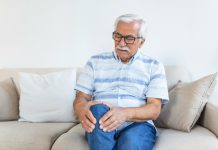
A new study from Rutgers School of Public Health found that despite medication being the most effective treatment for opioid use disorder (OUD), most people who might benefit from OUD treatment get no medication.
They found among those who may have needed treatment for their opioid use, only 28 percent received medication for OUD.
The study is published in JAMA Network Open and was conducted by Pia Mauro et al.
The findings were based on data from the 2019 National Survey on Drug Use and Health in the U.S. Participants were community-based respondents.
The researchers identified adolescents and adults who might benefit from medication for OUD.
They showed that 57 percent received no treatment for the disorder, and 15 percent received only services without medication.
Notably, adolescents (aged 12-17 years) did not receive medications for opioid use disorder (MOUD) in the past year and only 13 percent of adults 50 years and older received medication for the disorder.
Among adults, the likelihood of past-year MOUD receipt compared to no treatment was also lower for people ages 50 years or older versus for those 18 to 25 years of age.
Nearly one-third of non-Hispanic white people in need of OUD treatment received medication, compared with approximately 20 percent of people identifying as non-Hispanic Black or multiracial groups and 15 percent of Hispanic people.
In contrast, roughly similar proportions of each racial and ethnic group received non-medication services.
Medication for OUD was lower among women, more likely among adults with at least some college, and less likely in small metropolitan areas versus large metropolitan areas.
While contacts with the health care system (85 percent) and criminal legal system (60.5 percent) were common, most people encountering these systems did not report receiving medications for OUD (29.5 percent and 39 percent, respectively).
Recent studies have found the most effective drug for opioid use disorder, and opioids and dental pain: what you need to know, which are highly relevant to the current study.
Sign up for our newsletter for more information about this topic.
NIH has suggested people move beyond opioids to manage chronic pain.
ongoing pain causes distress and affects the quality of life. Pain is the number one reason people see a doctor.
A class of drugs called opioids is often used to treat pain. One reason, explains NIH pain expert Dr. Michael Oshinsky, is that opioids work well for many people.
Opioids can stop the body from processing pain on many levels, from the skin to the brain. Because they work throughout the body, he says, “Opioids can be very effective for multiple types of pain.”
But opioids also produce feelings of happiness and well-being. And they’re reinforcing: the more people take them, the more they crave them. This can lead to addiction, or continuing to take opioids despite negative consequences.
Scientists have not yet been able to develop opioids that reduce pain without producing these addicting effects, Oshinsky explains.
The longer someone takes opioids, the more they may need to take to get the same effect. This is called tolerance.
Having a high tolerance doesn’t always mean you’ll become addicted. But taking higher doses of opioids increases the risk for both addiction and overdose.
The U.S. is now in the grip of an opioid crisis. Every day, more than 100 Americans die from an opioid overdose. This number includes deaths from prescription opioids.
“We don’t need ‘better’ opioids. We need to move away from the reliance on opioids for developing pain treatments,” Oshinsky says.
Opioids are often prescribed for acute pain. Acute pain is short-term pain, the kind experienced after an accident or an operation.
But other drugs may be just as effective for acute pain, even after surgery, explains Dr. Dena Fischer, a dental health expert at NIH. Some of these drugs, like acetaminophen or ibuprofen, don’t require a prescription.
People may think that prescription drugs work better for acute pain. But that’s often not the case, Fischer says. Using something other than an opioid first can be especially important to manage acute pain in fields such as dentistry, she adds.
Many people receiving opioid prescriptions from dentists are teens or young adults who have never been prescribed an opioid before.
“Research is starting to tell us that people who receive an opioid prescription as a teenager have a tendency to continue to take opioids for non-medical purposes in the long term,” Fischer says.
Healthcare providers who decide their patient needs an opioid are now being encouraged to give only a few pills at a time.
People who receive shorter prescriptions are less likely to misuse their pills by taking more than prescribed or taking them after the pain is gone. This also cuts down the chance that the pills could be taken by others.
Managing chronic pain is more complicated than treating acute pain. More than 25 million people in the U.S. alone live with chronic pain, which is pain that lasts more than three months.
Many things can cause chronic pain. For example, Oshinsky says, a muscle that was damaged in an accident may heal relatively quickly.
But if a nerve was also hurt, it can continue to send pain signals long after the body has repaired the muscle.
Other types of chronic pain are driven by brain changes, explains Dr. David Williams, an NIH-funded pain researcher at the University of Michigan. When these changes happen, the brain continues to perceive pain even though the injury has healed.
For people with this type of chronic pain, sometimes called central pain, opioids and some other kinds of pain medications can actually make the pain worse.
Research has shown that talk therapies, such as cognitive-behavioral therapy, can help many people with chronic central pain.
These types of therapies “emphasize behaving in different ways or thinking in different ways that alter the perception of pain,” Williams explains. “Pain is a combination of a sensory and an emotional experience.”
Cognitive-behavioral therapy can also help people with chronic pain management related health problems, such as problems sleeping, feeling tired, or trouble concentrating.
This can increase the quality of life for people with chronic pain. It can also have overlapping effects.
“Pain processing and sleep and thinking and mood all share the same neurotransmitters in the brain,” Williams says. “So, by improving something like sleep, you’re also improving pain.”
Non-opioid drugs can help some people with chronic pain too, Oshinsky says. Many of these drugs were first developed to treat different health conditions, such as seizures, depression, or anxiety. But they can also change the way the brain processes pain.
Some people benefit from devices that stimulate the nerves directly to block pain signals from reaching the brain, Oshinsky adds. Different devices can work on different parts of the nervous system, from the nerves in the skin to the spinal cord.
People with certain types of pain have also been shown to benefit from exercise, acupuncture, massage therapy, or yoga.
The alternatives to opioids we have now don’t work for everyone’s pain. More non-opioid, non-addictive treatment options could help reduce the number of opioids prescribed each year.
More options for pain management could help doctors better personalize pain treatment.
If you care about opioid use, please read studies about life-saving treatment for nation’s opioid disorder epidemic, and more heart infections and strokes in the U.S. linked to opioid epidemic.
For more information about health, please see recent studies about how to reduce post-surgical pain without opioids, and results showing this vitamin deficiency may increase your risk of opioid addiction.
Copyright © 2022 Knowridge Science Report. All rights reserved.



